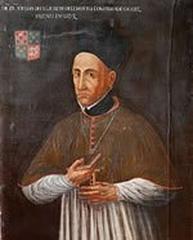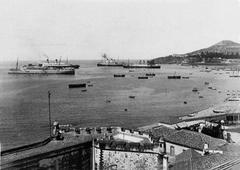Forte dos Louros: Visiting Hours, Tickets, and Exploring Funchal’s Hidden Coastal Fortress
Date: 04/07/2025
Introduction
Forte dos Louros is a captivating coastal fortress in Funchal, Madeira, offering visitors a fascinating glimpse into the island’s maritime and military history. Perched above the mouth of the Ribeira de Gonçalo Aires, this fortification is not only a testament to Renaissance military engineering but also a symbol of Madeira’s resilience and strategic significance throughout the centuries. While less imposing than some of Funchal’s other forts, Forte dos Louros played a vital part in protecting the city from piracy and foreign incursions. Today, it stands as both a historical monument and a scenic vantage point, perfect for those seeking to delve deeper into Madeira’s storied past.
This guide provides all the essential information for visiting Forte dos Louros, including opening hours, ticket details, accessibility, historical background, and recommendations for making the most of your visit. For official updates, consult the Madeira Tourism Official Website and the Funchal Municipality website.
Table of Contents
- Introduction
- Visitor Information
- Historical Background
- Cultural Significance
- Visiting Tips
- Nearby Attractions
- Frequently Asked Questions (FAQ)
- Conclusion and Call to Action
- References
Visitor Information
Opening Hours and Tickets
- Hours: Generally open to the public from 9:00 AM to 6:00 PM daily. During peak tourist seasons (spring and summer), hours may be extended; check local sources for any changes.
- Tickets: Entry is free. Occasionally, special events or guided tours may require a ticket; check with the official tourism office for updates.
- Guided Tours: While no permanent guided tours are dedicated solely to Forte dos Louros, it is often included in Funchal’s historical-military walking routes. Local tour operators may offer thematic tours that include the fort.
Getting There
Forte dos Louros is located in the São Gonçalo parish, about 5 km from central Funchal. The site is accessible by taxi, rental car, or public transportation. Walking from the city center is possible and recommended for those wishing to explore Funchal’s old town and waterfront along the way.
Accessibility
- The site features uneven terrain and cobblestone paths, which may pose challenges for visitors with mobility impairments.
- There are no on-site facilities such as restrooms or cafés, but the surrounding area provides amenities within walking distance.
Historical Background
Origins and Construction
Forte dos Louros was initially constructed in the late 16th century, with significant rebuilding during the 17th century, particularly around the Portuguese Restoration War (1640–1668). The site was designed as part of a broader defensive network to protect Funchal’s harbor from pirates, privateers, and hostile navies. Its robust basalt stone walls, angular bastions, and cannon embrasures showcase the influence of Renaissance military engineering adapted to Madeira’s volcanic landscape (Madeira-Web).
Architectural Features
- Materials: Built from local basalt and volcanic stone, providing durability against the Atlantic climate.
- Design: Features a polygonal plan, angled bastions, and thick walls. Sentry boxes, a central courtyard, and a small powder magazine are also present.
- Functionality: The fort was designed to accommodate a small garrison and artillery, with overlapping fields of fire to complement neighboring forts.
Role within Funchal’s Defenses
Forte dos Louros formed part of a defensive network that included the Forte de São Tiago, Fortaleza de Santo António da Alfândega, and others. These fortifications worked in concert to defend Funchal from seaborne threats, with each covering strategic approaches to the harbor (Visit Madeira - Monuments, Portugal Num Mapa). The fort’s location allowed it to coordinate with others and protect both commerce and local inhabitants.
Cultural Significance
Beyond its military function, Forte dos Louros has played an enduring role in Funchal’s cultural landscape. It has served as a community gathering spot and has occasionally hosted cultural events and educational programs, connecting residents and visitors to Madeira’s history. The fort’s preservation reflects local efforts to maintain the integrity of Funchal’s historic sites (Get To Hikes - Funchal Old Town Guide).
Visiting Tips
- Footwear: Wear sturdy, comfortable shoes for navigating cobblestones and uneven ground.
- Timing: Visit in the early morning or late afternoon for softer light, cooler temperatures, and fewer crowds.
- Essentials: Bring water and sun protection, as facilities are limited.
- Photography: The fort offers excellent vantage points for cityscape and coastal photography.
- Combine Visits: Forte dos Louros is best appreciated as part of a walking tour that includes Funchal’s other historic sites.
Nearby Attractions
- Forte de São Tiago: A restored fort now housing a contemporary art museum (Portugal Num Mapa).
- Rua de Santa Maria: Known for its colorful painted doors and vibrant street life (The Crazy Tourist).
- Mercado dos Lavradores: Funchal’s traditional market, ideal for sampling local produce (RandomTrip).
- Funchal Waterfront: A leisure area with cafés and harbor views (Full Suitcase).
Frequently Asked Questions (FAQ)
Q: What are the visiting hours for Forte dos Louros?
A: Typically open from 9:00 AM to 6:00 PM, with possible seasonal variations.
Q: Is there an entrance fee?
A: No, entry is free. Special events or guided tours may require a ticket.
Q: Is the site accessible for wheelchairs?
A: The fort’s terrain is uneven and may not be fully accessible for wheelchair users.
Q: Are guided tours available?
A: The fort is included in some walking tours of Funchal’s historical sites; inquire at the tourism office for schedules.
Q: Are there facilities at the site?
A: No, but amenities are available nearby in the old town district.
Conclusion and Call to Action
Forte dos Louros is a hidden gem among Funchal’s historical sites, offering a tranquil setting, scenic views, and a direct connection to Madeira’s layered past. Its accessibility, free entry, and proximity to other attractions make it a rewarding stop for both history enthusiasts and casual travelers. For an immersive experience, consider joining a guided tour or using the Audiala app for audio guides and curated itineraries.
Plan your visit today by consulting the Funchal Municipality website for up-to-date walking routes and event schedules, and enhance your exploration with digital resources and local insights.
References
- Forte dos Louros in Funchal: Visiting Hours, Tickets, and Historical Insights, 2025, Audiala Research Data (Madeira Tourism Official Website)
- Forte Dos Louros Visiting Hours, Tickets & Historical Guide to Funchal’s Coastal Fortress, 2025, (Madeira-Web)
- Forte dos Louros Visiting Hours, Tickets & Historical Guide to Funchal’s Hidden Fortress, 2025, (Visit Madeira - Monuments)
- Forte dos Louros Visiting Hours, Tickets & Guide to Funchal’s Historic Coastal Fort, 2025, (Visit Funchal)
- Additional Funchal and Madeira travel resources: (Full Suitcase), (The Crazy Tourist), (RandomTrip)
For a richer experience, explore virtual tours and interactive maps on official tourism sites. Download the Audiala app for audio guides and stay connected via social media for the latest updates on Madeira’s historical and cultural highlights.


